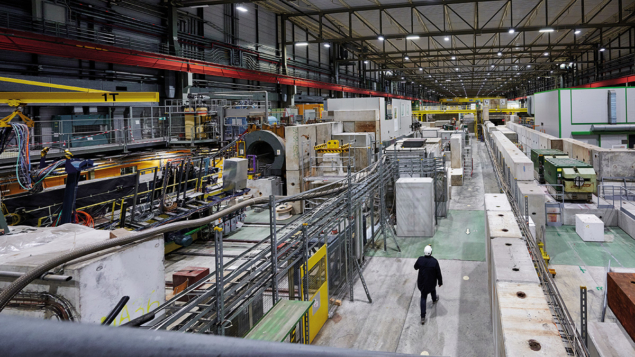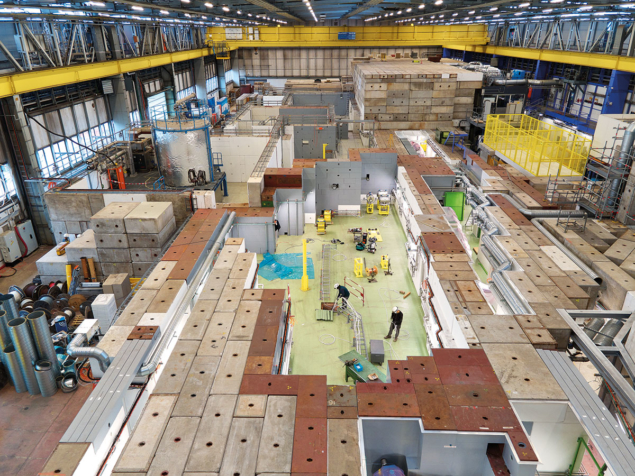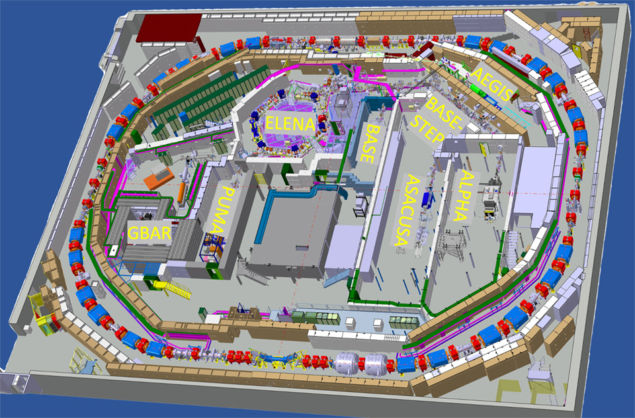The North and East experimental areas of CERN enable a wide range of measurements, from precision tests of the Standard Model to detector R&D. Kristiane Bernhard-Novotny takes a tour of their upcoming programmes.

While all eyes focus on the LHC restart, a diverse landscape of fixed-target experiments at CERN have already begun data-taking. Driven by beams from smaller accelerators in the LHC chain, they span a large range of research programmes at the precision and intensity frontiers, complementary to the LHC experiments. Several new experiments join existing ones in the new run period, in addition to a suite of test-beam and R&D facilities.
At the North Area, which is served by proton and ion beams from the Super Proton Synchrotron (SPS), new physics programmes have been underway since the return of beams last year. Experiments in the North Area, which celebrated its 40th anniversary in 2019, are located at different secondary beamlines and span QCD, electroweak physics and QED, as well as dark-matter searches. “During Long Shutdown 2, a major overhaul of the North Area started and will continue during the next 10 years to provide the best possible beam and infrastructure for our users,” says Yacine Kadi, leader of the North Area consolidation project. “The most critical part of the project is to prepare for the future physics programme.”
The first phase of the AMBER facility at the M2 beamline is an evolution of COMPASS, which has operated since 2002 and focuses on the study of the gluon contribution to the nucleon spin structure. By measuring the proton charge radius via muon–proton elastic scattering, AMBER aims to clarify the long-standing proton–radius puzzle, offering a complementary approach to previous electron–proton scattering and spectroscopy measurements. A new data-acquisition system will enable the collaboration to measure the antiproton production cross-section to improve the sensitivity of searches for cosmic antiparticles from possible dark-matter annihilation. A third AMBER programme will concentrate on measurements of the kaon, pion and proton charge radii via Drell-Yan processes using heavy targets.
A second North Area experiment specialising in hadron physics is NA61/SHINE, which underwent a major overhaul during Long Shutdown 2 (LS2), including the re-use of the vertex detector from the ALICE experiment. Building on its predecessor NA49, the 17 m-long NA61/SHINE facility, situated at the H2 beamline, focuses on three main areas: strong interactions, cosmic rays and cross-section measurements for neutrino physics. The collaboration continues its study of the energy dependence of hadron production in heavy-ion collisions, in which NA49 found irregularities. It also aims to observe the critical point at which the phase transition from a quark–gluon plasma to a hadron gas takes place, the threshold energy for which is only measurable at the SPS rather than at the higher energy LHC or RHIC experiments. By measuring hadron production from pion–carbon interactions, meanwhile, the team will study the properties of high-energy cosmic rays from cascades of charged particles. Finally, using kaons and pions produced from a target replicating that of the T2K experiment in Japan, NA61/SHINE will help to determine the neutrino flux composition at the future DUNE and Hyper-Kamiokande experiments for precise measurements of neutrino mixing angles and the CP-violating phase.
New physics
Situated at the same H2 beamline, the new NA65 “DsTau” experiment will study the production of Ds mesons. This is important because Ds decays are the main source of ντ’s in a neutrino beam, and are therefore relevant for neutrino-oscillation studies. After a successful pilot run in 2018, a measurement campaign began in 2021 to determine the ντ-production flux.

At the K12 secondary beamline, NA62 continues its measurement of the ultra-rare charged kaon decay to a charged pion, a neutrino and an antineutrino, which is very sensitive to possible physics beyond the Standard Model. The collaboration aims to increase its sensitivity to a level (10%) approaching theoretical uncertainties, thanks to further data and experimental improvements to the more than 200 m-long facility. One is the installation during LS2 of a muon veto hodoscope that helps to determine whether a muon is coming from a kaon decay or from other interactions. Since 2021, NA62 also operates as a beam-dump experiment, where its primary focus is to search for feebly-interacting particles. Here, the ability to determine whether muons come from the target absorber is even more important since they make up most of the background.
Dark interactions
Searching for new physics is the focus of NA64 at the H4 beamline, which studies the interaction between an electron beam and an active target to look for a hypothetical dark-photon mediator connecting the SM with a possible dark sector. With at least five times more data expected this year, and up to 10 times more data during the period of LHC Run 3, it could be possible to determine whether the dark mediator, should it exist, is either an elastic scalar or a Majorana particle. Adding further impetus to this programme is an unexpected 17 MeV peak reported in e+e– internal pair production by the ATOMKI experiment and, more significantly, the tension between the measured and predicted values of the anomalous magnetic moment of the muon (g-2)μ, for which possible explanations include models that invoke a dark mediator. During a planned muon run at the M2 beamline, the collaboration aims to cover the relevant parameter space for the (g-2)μ anomaly.
NA63 also receives electrons from the H4 beamline and uses a high-energy electron beam to study the behaviour of scattered electrons in a strong electromagnetic field. In particular, the experiment tests QED at higher orders, which have a gravitational analogue in extreme astroparticle physics phenomena such as black-hole inspirals and magnetars. The NA63 team will continue its measurements in June.
Besides driving the broad North Area physics programme, the SPS serves protons to AWAKE – a proof-of-principle experiment investigating the use of plasma wakefields driven by a proton bunch to accelerate charged particles. Following successful results from its first run, the collaboration aims to further develop methods to modulate the proton bunches to demonstrate scalable plasma-wakefield technology, and to prepare for the installation of a second plasma cell and an electron-beam system using the whole CNGS tunnel at the beginning of LS3 in 2026.
Located on the main CERN site, receiving beams from the Proton Synchrotron (PS), the East Area underwent a complete refurbishment during LS2, leading to a 90% reduction in its energy consumption. Its main experiment is CLOUD, which simulates the impact of particulates on cloud formation. This year, the collaboration will test a new detector component called FLOTUS, a 70 litre quartz chamber extending the simulation from a period of minutes to a maximum of 10 days. The PS also feeds the n_TOF facility, which last year marked 20 years of service to neutron science and its applications. A new third-generation spallation target installed and commissioned in 2021 will enable new n_TOF measurements relevant for nuclear astrophysics.
Different dimensions
Taking CERN science into an altogether different dimension, the PS also links to the Antimatter Factory via the Antiproton Decelarator (AD) and ELENA rings, where several experiments are poised to test CPT invariance and antimatter gravitational interactions at increased levels of precision (see “Antimatter galore at ELENA” panel). Even closer to the proton beam source is the PS Booster, which serves the ISOLDE facility. ISOLDE covers a diverse programme across the physics of exotic nuclei and includes MEDICIS (devoted to the production of novel radioisotopes for medical research), ISOLTRAP (comprising four ion traps to measure ions) and COLLAPS and CRIS, which focus on laser spectroscopy. Its post-accelerators REX/HIE-ISOLDE increase the beam energy up to 10 MeV/u, making ISOLDE the only facility in the world that provides radioactive ion-beam acceleration in this energy range.
Antimatter galore at ELENA

Served directly by the Antiproton Decelerator (AD) for the past two decades, experiments at the CERN Antimatter Factory are now connected to the new ELENA ring, which decelerates 5.3 MeV antiprotons from the AD to 100 keV to allow a 100-fold increase in the number of trapped antiprotons. Six experiments involving around 350 researchers use ELENA’s antiprotons for a range of unique measurements, from precise tests of CPT invariance to novel studies of antimatter’s gravitational interactions.
The ALPHA experiment focuses on antihydrogen-spectroscopy measurements, recently reaching an accuracy of two parts per trillion in the transition from the ground state to the first excited state. By clocking the free-fall of antiatoms released from a trap, it is also planning to measure the gravitational mass of antihydrogen. ALPHA’s recent demonstration of laser-cooled antihydrogen has opened a new realm of precision on anti-hydrogen’s internal structure and gravitational interactions to be explored in upcoming runs.
ASACUSA specialises in spectroscopic measurements of antiprotonic helium, recently finding surprising behaviour. The experiment is also gearing up to perform hyperfine-splitting spectroscopy in antihydrogen using atomic-beam methods complementary to ALPHA’s trapping techniques.
GBAR and AEgIS target direct measurements of the Earth’s gravitational acceleration on antihydrogen. GBAR is developing a method to measure the free-fall of antihydrogen atoms, using sympathetic laser cooling to cool antihydrogen atoms and release them, after neutralisation, from a trap directly injected with antiprotons from ELENA, maximising antihydrogen production. AEgIS, having established pulsed formation of antihydrogen in 2018, is following a different approach based on measuring the vertical drop of a pulsed cold beam of antihydrogen atoms travelling horizontally through a device called a Moiré deflectometer.
BASE uses advanced Penning traps to compare matter and antimatter with extreme precision, recently finding the charge-to-mass ratios of protons and antiprotons to be identical within 16 parts per trillion. The data also allowed the collaboration to perform the first differential test of the weak equivalence principle using antiprotons, reaching the 3% level, with experiment improvements soon expected to increase the sensitivities of both measurements. The BASE team is also working on an improved measurement of the antiproton magnetic moment, the implementation of a transportable antiproton trap called BASE-STEP and improved searches for millicharged particles.
The newest AD experiment, PUMA, which is preparing for first commissioning later this year, aims to transport trapped antiprotons collected at ELENA to ISOLDE where, from next year, they will be annihilated on exotic nuclei to study neutron densities at the surface of nuclei.
“Thanks to the beam provided by ELENA and the major upgrades of the experiments, we hope to see big progress in ultra-precise tests of CPT invariance, first and long-awaited antihydrogen-based studies of gravity, as well as the development of new technologies such as transportable antimatter traps,” says Stefan Ulmer, head of the AD user committee.
Stable and highly customisable beams at the North and East areas also facilitate important detector R&D and test-beam activities. These include the recently approved Water-Cherenkov Test Experiment, which will help to develop detector techniques for long-baseline neutrino experiments, and new detector components for the LHC experiments and proposed future colliders. The CERN Neutrino Platform is dedicated to the development of detector technologies for neutrino experiments across the world. Upcoming activities including ongoing contributions to the future DUNE experiment in the US, in particular the two huge DUNE cryostats and R&D for “vertical drift” liquid-argon detection technology. In the East Area, the mixed-field irradiation (CHARM) and proton-irradiation (IRRAD) facilities provide key input to detector R&D and electronics tests, similar to the services provided by the SPS-driven GIF irradiation facility and HiRadMat.
With the many physics opportunities mapped out by Physics Beyond Colliders and the consolidation of our facilities, we are looking into a bright future
Johannes Bernhard
Fixed-target experiments in the North and East areas, along with experiments at ISOLDE and the AD, demonstrate the importance of diverse physics studies at CERN, when the best path to discover new physics is unclear. Some of these experiments emerged within the Physics Beyond Colliders initiative and there are many more on the horizon, such as KLEVER and the SPS Beam Dump Facility. “With the many physics opportunities mapped out by Physics Beyond Colliders and the consolidation of our facilities, we are looking into a bright future,” says Johannes Bernhard, head of the liaison to experiments section in the beams department. “We are always aiming to serve our users with the highest beam quality and performance possible.”





